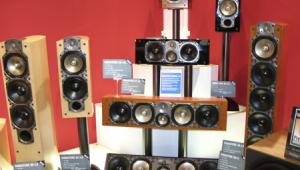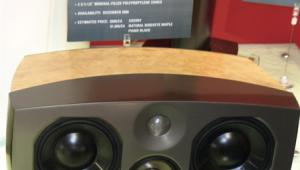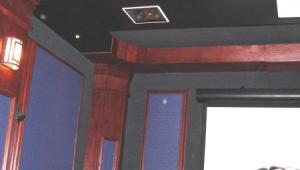CES 2011 Video Wrap-Up

Of the video trends I followed at CES this year, the most obvious were more evolutionary than revolutionary—more 3D models and more online apps in what are being called Smart TVs by more than one manufacturer. These apps are also available in Blu-ray players and tablets, providing various ways to access an ever-wider range of online content as well as media files stored on networked devices within the home.
One interesting wrinkle in the 3D marketplace was the appearance of 3D LCD TVs that use passive-polarized glasses instead of active-shutter glasses; the largest proponents of passive 3D at CES were LG and Vizio. The advantages of this approach are many—the glasses are much lighter in weight and lower in cost, they have no electronics and thus no battery that must be recharged or replaced, and they can be implemented in a wide variety of frame styles and even made with prescription lenses. In addition, they are not limited to one manufacturer's TVs, and they can also be used in RealD-based commercial cinemas, but not Imax or Dolby 3D.
A passive 3D image is often said to be brighter because passive glasses let more light through, but there is some debate about this, since the polarizing film placed in front of the screen reduces the TV's overall light output. Also, there is no flickering in the image as some viewers report with active-shutter glasses, and they work just fine if your head is at an angle—say, if you're lying on the sofa. With 3D LCD TVs that use shutter glasses, tilting your head results in either crosstalk (e.g., Sony) or a dimmer image (e.g., Samsung). This is not a problem with 3D plasma TVs that use shutter glasses.
If passive 3D is so great, why don't all manufacturers use it? The biggest complaint is that passive-3D flat panels cut the vertical resolution seen by each eye in half—that is, each eye sees a resolution of 1920x540. Why? Because the horizontal lines that make up a TV image are polarized alternately—one eye sees lines 1, 3, 5, etc. while the other eye sees lines 2, 4, 6, etc. Passive proponents claim that the brain fuses these two images into one 1920x1080 image, and the human visual system is not as sensitive to vertical resolution as it is to horizontal resolution, so it's not the problem that detractors claim it to be.
By contrast, 3D flat panels that use shutter glasses display the left- and right-eye images at full 1920x1080 resolution by alternating them on the screen. The lenses in shutter glasses alternately open and close in sync with the left and right images, so each eye sees only what it's supposed to. In most cases, the TV inserts a brief black field between subsequent images, and the glasses close both lenses during that interval in order to reduce crosstalk or "ghosting," which also reduces the amount of light reaching your eyes and contributes to the flickering that some viewers report.
Another historical disadvantage of passive 3D TVs is their cost—the glasses are much less expensive, but the TV itself has traditionally been much more expensive than a comparable active-shutter model, because the polarizing filter on the screen must be made to very exact tolerances. However, I was told that recent advances in manufacturing techniques and materials have all but eliminated this cost differential.
As I was looking at various passive 3D displays during the show, I didn't see much of a reduction in sharpness and detail, though I suspect the image might look softer at very large screen sizes. Also, every demo was displaying 3D Blu-ray content; 3D broadcasts could pose more of a problem in this regard, since they transmit half resolution for each eye with the two images either side by side or one on top of the other within a 1920x1080 frame. This cuts the horizontal or vertical resolution in half, respectively, so with side-by-side broadcasts, a passive 3D TV has only 960x540 pixels of picture information for each eye, while top-bottom broadcasts on such a set has 1920x540 pixels for each eye. In both cases, the TV's processor decodes the signal into a double image that fills the screen and interpolates the missing pixels, which improves the perceived resolution but might also introduce visible artifacts.
The passive displays did seem a bit brighter to me, and the horizontal viewing angle seemed wider than with many 2D LCDs. However, the vertical viewing angle was very limited, with lots of crosstalk if I got much above or below the center of the screen.
Looking at the two technologies side by side at the LG Display press conference, the passive displays had a smoother, more comfortable look, while I did see just a hint of flicker in the active displays, though this has never bothered me when looking at an active display in isolation. Finally, I thought the passive 3D images looked a bit washed out, while the active 3D images were punchier.
My biggest concern with passive 3D is what the polarizing film might do to 2D images, which will comprise the vast majority of TV programming for some time to come. What artifacts might that film introduce to 2D programs? Perhaps aberrations in grayscale, color, and/or gamma? Of course, we didn't see any 2D material displayed on passive-3D sets at the show, so any evaluation of this will have to wait until we get one in for review.
The other big 3D news was autostereoscopic TVs—that is, 3D without the need for glasses at all. Sony had some 24-inch OLED prototypes on display, and Toshiba had a 55-inch model that it intends to sell this year. With this technology, you must be in one of several very specific positions relative to the screen—there were marks on the floor indicating where viewers should stand. If you moved even a few inches one way or the other, the 3D effect fell apart completely with lots of wavy distortions until you reached another of the designated positions. And standing in one of those positions, the 3D effect was more subtle than either active or passive glasses can achieve. As appealing as 3D without glasses is, I doubt that consumers will buy into this approach.
- Log in or register to post comments



































































